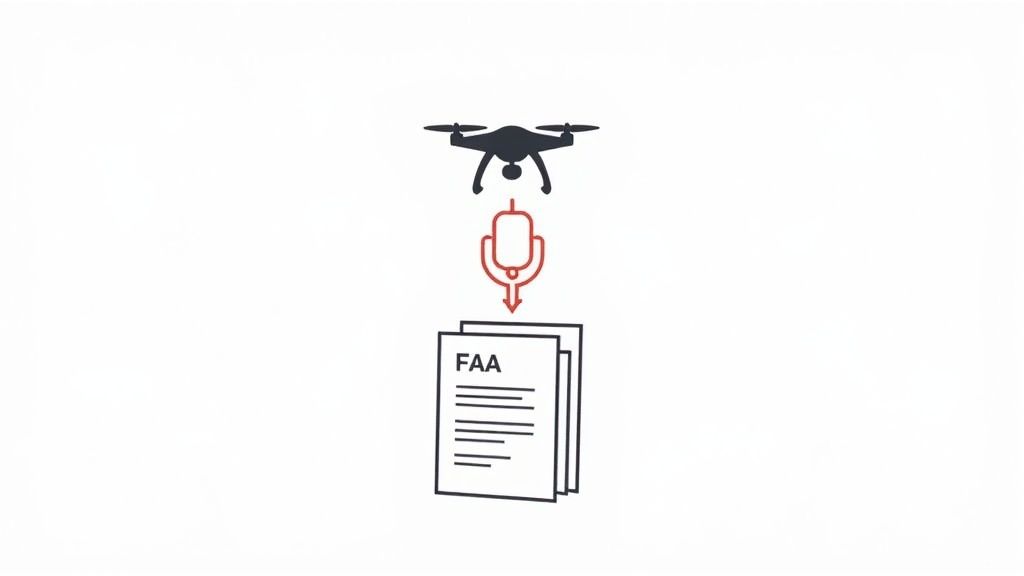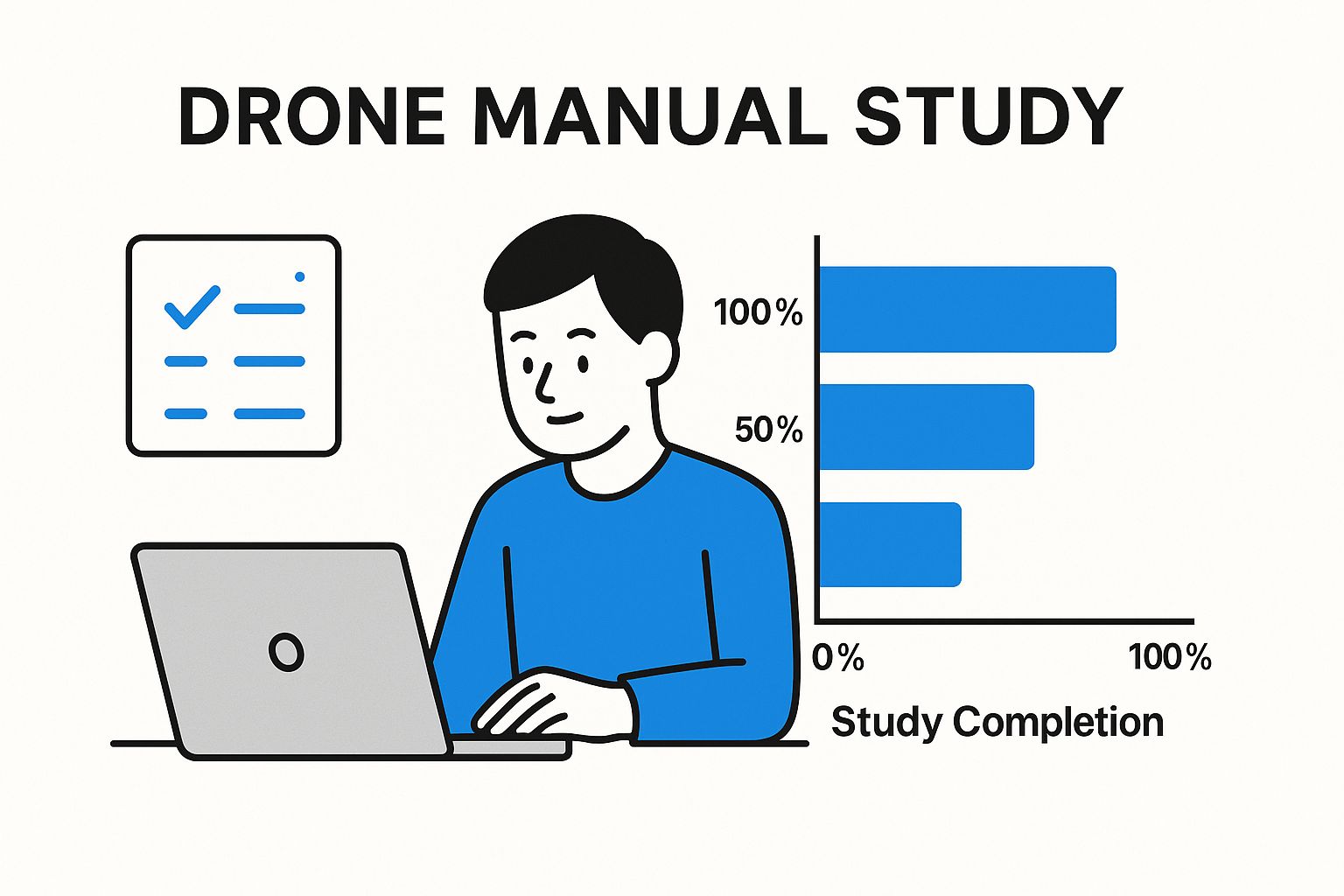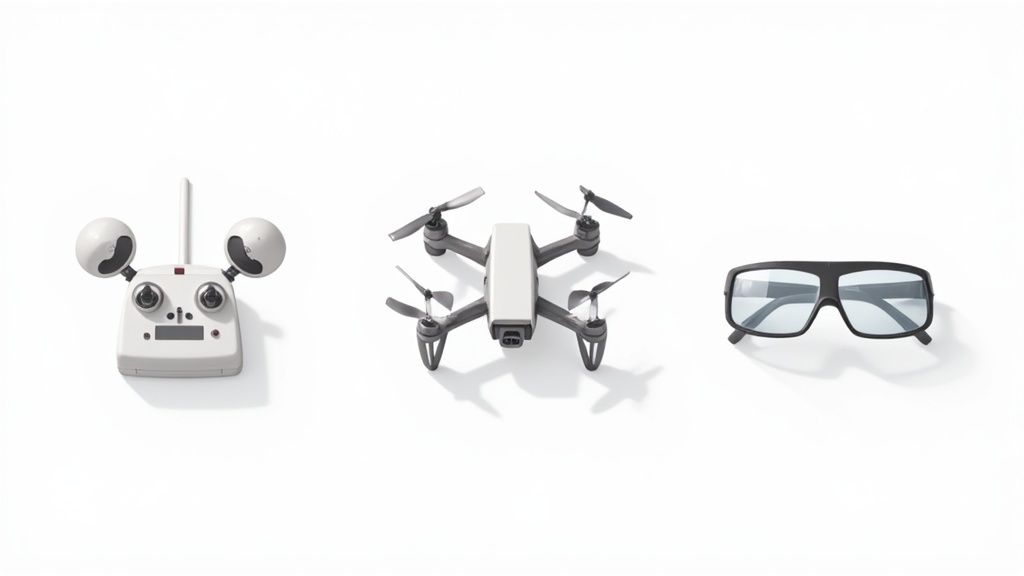How to Get a Commercial Drone License: Proven Success Guide
- Paul Simmons

- Jun 7
- 10 min read
Updated: Jun 11
Understanding What It Really Takes To Get Licensed

So, you dream of turning your drone hobby into a thriving business? It's an exciting prospect, but before you start charging for those breathtaking aerial shots, it's essential to understand the legal requirements. This means getting your hands on a commercial drone license, formally known as the Part 107 Remote Pilot Certificate.
Why A Commercial Drone License Is Essential
Many aspiring drone entrepreneurs wonder, "Do I really need a license?" The short answer is yes, if you're earning any money with your drone. Any operation involving compensation – even seemingly small tasks like photographing a friend's real estate listing – falls under commercial activity. This requires a Part 107 license. Operating without one risks substantial fines and legal issues, potentially grounding your drone business before it even takes off. For more insights, check out this helpful article: Why you need a 107 license.
Key Requirements For The Part 107 Certificate
Getting your Part 107 license involves a few important steps. First, you must be at least 16 years old. You'll also need to pass a Transportation Security Administration (TSA) background check. This process ensures responsible drone use and safeguards our airspace.
The process also includes a knowledge test administered by the Federal Aviation Administration (FAA). The exam covers topics ranging from airspace regulations and weather interpretation to safe flight practices. This prepares you for safe and legal commercial drone operations.
The Growing Demand For Licensed Drone Pilots
Understanding the industry’s scale is key to obtaining a commercial drone license. As of April 1, 2025, over 1 million drones were registered in the United States, with 420,825 registered for commercial use. This demonstrates the growing demand for drones across various sectors, including construction, agriculture, and inspection services. Learn more about these statistics here.
The construction industry alone is projected to hold approximately 12% of the total commercial drone market share by 2025. This growth presents substantial opportunities for licensed drone operators to expand their services. Getting your Part 107 license isn't just about compliance; it's about positioning yourself in a rapidly expanding industry. By understanding the rules and passing the exam, you'll unlock exciting and profitable opportunities in the dynamic drone industry.
Mastering the Part 107 Exam Like a Pro
Passing the Part 107 exam isn't about memorizing facts; it's about understanding the core principles of safe and legal commercial drone operations. This section breaks down the key knowledge areas you need to succeed.
Key Knowledge Areas
The Part 107 exam assesses your grasp of various topics essential for responsible commercial drone operations. These include:
Regulations: A solid understanding of Part 107's rules is crucial. This encompasses operational limitations, licensing requirements, and your responsibilities as a commercial drone pilot.
Airspace Classification: Knowing how to interpret airspace classifications and obtain proper authorization for controlled airspace is vital. This means understanding the different airspace classes and their restrictions.
Weather Interpretation: Accurate weather interpretation is essential for safe flights. This includes recognizing hazardous weather and making informed decisions based on forecasts.
Aircraft Performance: Understanding your drone's capabilities and limitations is key. This covers factors affecting flight time, range, and performance in different conditions.
Safe Operations: Practicing safe flight procedures, emergency protocols, and pre-flight checks is fundamental. This includes risk assessment and mitigation.

The infographic above illustrates the importance of Part 107 exam preparation, emphasizing study materials and checklists. Effective studying and planning are your keys to success.
To provide a clearer view of the exam's structure and how to allocate your study time, let's look at the following table:
Part 107 Exam Knowledge Areas Breakdown
Knowledge Area | Percentage of Exam | Recommended Study Hours | Difficulty Level |
|---|---|---|---|
Regulations | 40% | 20 | Medium |
Airspace Classification | 25% | 15 | Hard |
Weather Interpretation | 15% | 10 | Medium |
Aircraft Performance | 10% | 8 | Easy |
Safe Operations | 10% | 7 | Easy |
This table outlines the relative weight of each knowledge area on the exam, providing a suggested number of study hours and a general difficulty rating. Focusing your efforts on the more heavily weighted and challenging areas can greatly improve your chances of success.
Effective Study Strategies and Resources
Successful pilots stress understanding the why behind regulations, not just memorizing them. Understanding the reasoning behind airspace restrictions, for example, makes applying those rules in different situations easier. This is much more effective than rote memorization. Practicing with sample questions and simulated scenarios builds confidence and prepares you for the exam format. You might find this helpful: How to master the Part 107 exam.
Common Pitfalls to Avoid
Misinterpreting questions due to time pressure or not reading carefully is a common mistake. Another pitfall is overemphasizing obscure rules while neglecting core concepts. The exam assesses your overall understanding of safe drone operation. Mastering core principles is more important than memorizing every rule. Effective time management during the 60-question exam is critical. Allocate your time wisely to avoid rushing through complex scenario-based questions. Understanding these pitfalls and using effective study strategies will prepare you to ace the Part 107 exam and begin your commercial drone career.
Navigating the Testing Process Without the Headaches

Now that you have a grasp of the exam content, let's focus on the testing process itself. This journey involves several key steps, from setting up your account to knowing what to expect on exam day. This section will provide a clear guide through each stage, making the experience smoother and less stressful.
Setting Up Your IACRA Account
The first step is establishing an Integrated Airman Certification and/or Rating Application (IACRA) account. This is the Federal Aviation Administration (FAA)'s web-based system for managing pilot certifications. Your IACRA account is essential for scheduling your exam and monitoring your progress. It’s a crucial first step on your path to obtaining a commercial drone license.
Choosing a Testing Center
Next, you'll need to choose a PSI testing center that's convenient for you. These centers are located nationwide, offering flexibility in scheduling. When making your selection, consider factors such as location, availability, and any reviews from other test-takers.
What to Expect on Exam Day
Knowing what to expect on exam day can significantly reduce pre-exam nerves. Make sure to arrive early with your required identification, including a government-issued photo ID. Remember that electronic devices are generally prohibited within the testing area. Familiarize yourself with the testing center’s specific rules and regulations in advance.
Timelines, Costs, and Payment
The entire process, from creating your account to receiving your temporary certificate, usually takes a few weeks. The exam fee is $175, and testing centers typically accept various payment methods. Understanding these details helps you budget accordingly and manage your expectations.
Tips From Recent Test-Takers
Recent test-takers offer valuable advice: bring essential materials like pens and scratch paper, if allowed by the testing center. They also recommend confirming your appointment and the center's location a day or two beforehand. Arriving early gives you ample time to check in and settle down before the exam begins.
Scheduling Strategies
Strategic scheduling can help minimize stress. Book your exam date well in advance, especially during peak periods, to secure your preferred time and location. This proactive approach prevents last-minute scrambling and allows for more focused study time. With proper preparation and a clear understanding of the process, you can confidently navigate your way to becoming a certified commercial drone pilot.
Finding Your Profitable Niche in the Drone Market
Earning your commercial drone license is a big accomplishment, but the journey doesn't end there. The real key to success is finding a profitable niche in the drone market. This means understanding where the demand is and how your unique skills can fill that need.
Lucrative Sectors for Drone Operators
Several industries are brimming with opportunities for skilled drone pilots. Real estate photography continues to be a popular and relatively easy entry point, offering good pay for high-quality aerial images. However, be prepared for competition.
Industrial inspections, alternatively, often demand higher rates due to the specialized skill set required. This kind of work might involve thermal imaging or other advanced sensor technology.
Emerging Opportunities
Looking beyond the well-established fields reveals emerging opportunities many pilots haven't considered. Search and rescue operations are increasingly using drones to cover large areas efficiently. Environmental monitoring is another growing area where drones monitor pollution levels and track wildlife.
Infrastructure assessment is also gaining traction. Drones provide cost-effective solutions for inspecting bridges, power lines, and other essential structures. For more ideas, check out this helpful resource: Top Drone Business Ideas To Launch In 2025.
The commercial drone market is rapidly growing, with North America in a leading position. The region comprises about 40% of the global market, and within North America, the United States holds over 85% of the market share. Fueled by a 19.5% CAGR from 2021 to 2028, the global drone market is projected to reach $57.8 billion by 2030. The commercial service market alone is expected to hit $29.4 billion by 2025. More statistics are available here. This growth underlines the significant opportunities available for licensed commercial drone pilots.
Pricing and Client Acquisition
Building a profitable business requires understanding industry pricing. This includes hourly rates, project-based fees, and any value-added services you offer.
Equally important is developing effective client acquisition strategies. Build a strong online presence, network with potential clients, and create a compelling portfolio showcasing your skills. The key is to position yourself competitively without undervaluing your services.
Identifying Underserved Markets
Targeting underserved markets in your local area can be a powerful way to build a successful drone business. Research local industries, understand their specific needs, and tailor your services accordingly. Connecting with key decision-makers in these industries can establish you as the go-to drone service provider. As you gain experience and build your reputation, strategically scaling your services will be key to long-term growth.
Building a Sustainable Drone Business That Grows
Your newly acquired commercial drone license opens a world of possibilities. But turning that license into a profitable venture takes more than just piloting skills. It requires strategic planning, sound business decisions, and a thorough understanding of the drone industry.
Essential Business Considerations
Building a sustainable drone business hinges on several key factors. Equipment selection is crucial. Striking a balance between high-quality gear and budget constraints is essential. Investing in dependable drones and payloads tailored to your target market is key for delivering professional results. Want to learn more about registering your drone? Check out this guide: How to master FAA Drone Registration.
Insurance is another must-have. Sufficient coverage protects your business from potential liabilities. Understanding the specific insurance needs for commercial drone operations is vital for risk mitigation. This protects your investment and gives you peace of mind.
Legal compliance goes beyond Part 107 regulations. Staying up-to-date on local and state drone laws ensures you operate legally. This proactive approach avoids potential legal headaches down the line.
Structuring Your Business and Marketing Your Services
The right business structure is critical for long-term success. Choosing between a sole proprietorship, LLC, or other structures depends on your business goals and finances. This decision impacts your taxes and legal responsibilities.
Marketing is essential for any business. A targeted marketing strategy is vital for reaching potential clients. This might involve creating a professional website, using social media, and networking within your industry.
Building credibility is especially important in the drone industry. Many clients have had bad experiences with inexperienced operators. Showcasing your certifications, highlighting your portfolio, and providing excellent customer service builds trust and sets you apart.
Expanding Your Opportunities and Scaling Your Operations
The commercial drone market is expanding rapidly. By 2024, there were 2.8 million units worldwide, and projections show growth to 4.5 million by 2029, with a CAGR of 9.9%. This report offers detailed statistics. This growth underscores the significant potential for licensed commercial drone operators.
Consider getting additional certifications beyond Part 107. Specialized certifications in areas like thermography, photogrammetry, or precision agriculture can lead to higher-paying jobs.
Networking within the drone community is important for staying informed about industry trends and connecting with potential partners. Joining professional organizations and attending industry events can expand your network and create valuable relationships.
Pricing Strategies and Market Demand
Understanding pricing is key for profitability. Researching typical rates for various drone services in your area provides a benchmark for your pricing strategy. This helps you set competitive rates while ensuring you make a profit. The table below offers a starting point:
To help you understand the current market, we've compiled a table showcasing average pricing for common drone services. This should give you a good foundation as you begin your research.
Commercial Drone Service Pricing Comparison
Service Type | Hourly Rate Range | Project Rate Range | Industry Demand |
|---|---|---|---|
Aerial Photography | $100-$300 | $500-$1500 | High |
Videography | $150-$400 | $750-$2000 | Medium |
Inspections | $200-$500 | $1000-$2500 | Growing |
Mapping/Surveying | $250-$600 | $1250-$3000 | High |
Remember, these are average ranges. Actual pricing varies based on location, experience, and project specifics.
As your business grows, strategically scaling your operations is important. This could mean hiring other pilots, investing in better equipment, or expanding the services you offer. Careful planning and execution are crucial for managing growth without sacrificing quality or customer satisfaction. By focusing on these key areas, you can turn your commercial drone license into a thriving and successful business.
Staying Current and Competitive Long-Term
Obtaining your commercial drone license, or Part 107 certificate, is a significant first step. But staying competitive in the dynamic drone industry demands continuous learning and adaptation. This section explores maintaining your license, improving your skills, and building a thriving drone business for the long haul.
Maintaining Your License and Staying Up-to-Date
The FAA mandates a biennial flight review for commercial drone pilots to maintain their Part 107 license. This review ensures proficiency with current regulations and safe operating procedures. It's a valuable opportunity to refresh your knowledge and refine your skills.
Staying informed about evolving regulations is also critical. The drone industry constantly changes, with new rules and guidelines frequently emerging. Subscribing to FAA updates and industry publications keeps you informed and helps you avoid penalties.
Embracing Technology and Enhancing Your Skillset
Beyond mandatory requirements, recurrent training significantly boosts your skills and marketability. Consider specialized training in areas like thermography, photogrammetry, or LiDAR. These certifications broaden your service offerings and command higher rates. For instance, thermal imaging expertise opens doors to inspecting solar panels, power lines, and other infrastructure.
Keeping pace with new technology is equally important. The drone industry is rapidly evolving, with constant advancements in hardware and software. Staying current with the latest drone models, cameras, and software like Pix4D gives you a competitive edge.
Best Practices for Long-Term Success
Experienced commercial pilots emphasize meticulous flight logging. Detailed records of your flights, including location, duration, and any incidents, are invaluable for insurance and potential FAA inspections. These logs demonstrate professionalism and a commitment to safety.
Understanding your insurance coverage is also crucial. Different policies offer varying protection levels. Adequate liability coverage is essential to protect your business from accidents. Regularly review your policy and adjust coverage as your operations expand.
Preparing for potential FAA inspections shouldn't be stressful. Maintaining organized records, adhering to regulations, and staying informed about best practices will simplify any inspection.
Building Your Network and Growing Your Business
Joining professional organizations like the Association for Unmanned Vehicle Systems International (AUVSI) (AUVSI) provides valuable resources, networking opportunities, and industry insights. Connecting with other commercial pilots allows for knowledge sharing and potential partnerships.
Networking within the drone community can open doors to new clients and opportunities. Attending industry events and conferences helps you stay current with trends and connect with key players. This also allows you to showcase your expertise.
Finally, never stop learning. The drone industry rewards those who adapt and evolve. Continuously seeking new knowledge, embracing best practices, and staying informed about regulations and technology will ensure long-term success as a commercial drone operator.
Ready to advance your drone journey? Explore JAB Drone for in-depth reviews, industry insights, and expert advice.




Comments